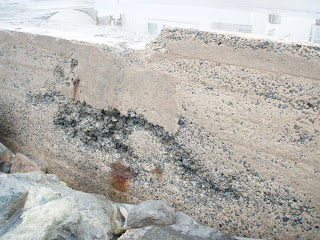“The fact is that there is not enough engineering to go around to mitigate the rising sea” - Jim Schultz from "Front-Line City in Virginia Tackles Rise in Sea", NYT 11/25/2010
Sea level rise and coastal management were the focus of a NY Times article,
Front-Line City in Virginia Tackles Rise in Sea, which appeared this past Thursday. This article might be getting a lot of attention because of the
United Nations Climate Change Conference happening in Cancun this week, but it's always good to see some attention to a major topic that effects coastal communities. The article points out that sea level rise is a real problem in Norfolk, VA and floods are a common occurrence after rains and during a high tide. If you've never been to Norfolk, it is surrounded by water, and like many coastal towns along the US east coast, it is built on filled in wetlands. While the article acknowledges that the fill is compacting and the town is sinking, it highlights a situation which may become more common if sea level rise estimates come true in the coming years.
While the skeptics will focus the argument on whether or
not global warming is causing sea-level rise, the problem remains that the home of world's largest navy installation, Naval Station Norfolk, has done little to prepare for sea level rise. The city of Norfolk has opted to throw money at the problem, recently hiring Fugro, a Dutch conglomerate, to "to evaluate options like inflatable dams and storm-surge floodgates at the entrances to waterways". You may know Fugro as an oil & gas consultant to US drilling and production, but they also provide environmental services.
"Along the Atlantic, 60 percent of the coastline that sits less than three feet above sea level has been opened for new houses, hotels, businesses, and roads. (By contrast, only 10 percent has been set aside for conservation.)"
Land use agencies along the east coast have either dragged their feet or ignored establishing policies to deal with the consequences of sea-level rise. And unless coastal retreat is considered, hard shoreline armoring may become a more common sight along the east coast.
Along Southern California coasts, erosion continues to be a problem, and most of the municipalities in San Diego County do not have policies in place to deal with sea level rise predictions.
Whether or not you believe in sea-level rise, the state of California does, and on November 14, 2008, Governor Schwarzenegger signed
Executive Order S-13-08 to create statewide consistency in planning for sea level rise. The executive order calls for, among other things, the completion of a Sea Level Rise Assessment Report, the consideration of sea level rise scenarios for the years 2050 and 2100, and the development of a Climate Adaptation Strategy. Consistent with the executive order, the governing board of the Coastal Conservancy adopted interim sea level rise rates (Adopted June 4, 2009): (a) 16 inches (40 cm) by 2050; and (b) 55 inches (140 cm) by 2100 for use in reviewing the vulnerability of projects it funds. (lifted from
"A report of sea level rise preparedness" from the California State lands commission).
The California State Lands Commission will provide a one-year status update on implementation of the recommendations of the Report on Sea Level Rise Preparedness at their upcoming meeting to be held at 10:00 AM on December 10, 2010 at the Port of San Diego. Click here for the
Agenda.
These recommendations are required to be included in any federal or state coastal project, which includes coastal erosion mitigation projects from Dept of Boating and Waterways and Army Corps of Engineers.
Personally, I think the big issue is forcing coastal municipalities to take sea level rise seriously and begin the discussion about which parts of our coast can be managed by strategic retreat.




























